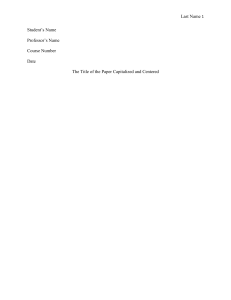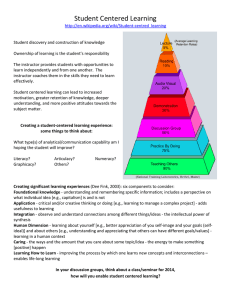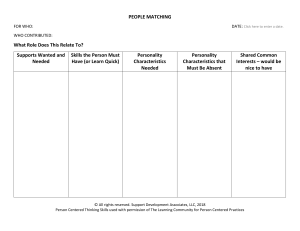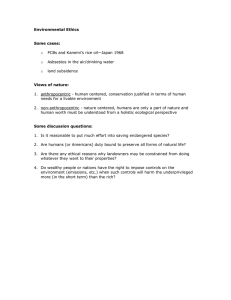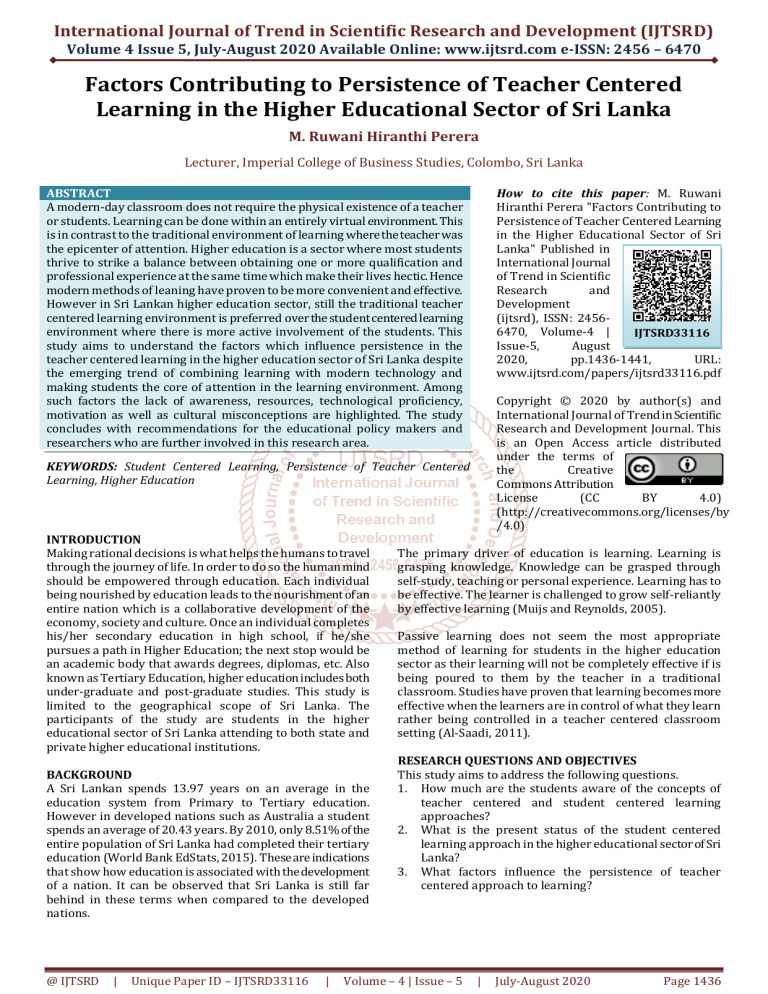
International Journal of Trend in Scientific Research and Development (IJTSRD)
Volume 4 Issue 5, July-August 2020 Available Online: www.ijtsrd.com e-ISSN: 2456 – 6470
Factors Contributing to Persistence of Teacher Centered
Learning in the Higher Educational Sector of Sri Lanka
M. Ruwani Hiranthi Perera
Lecturer, Imperial College of Business Studies, Colombo, Sri Lanka
ABSTRACT
A modern-day classroom does not require the physical existence of a teacher
or students. Learning can be done within an entirely virtual environment. This
is in contrast to the traditional environment of learning where the teacher was
the epicenter of attention. Higher education is a sector where most students
thrive to strike a balance between obtaining one or more qualification and
professional experience at the same time which make their lives hectic. Hence
modern methods of leaning have proven to be more convenient and effective.
However in Sri Lankan higher education sector, still the traditional teacher
centered learning environment is preferred over the student centered learning
environment where there is more active involvement of the students. This
study aims to understand the factors which influence persistence in the
teacher centered learning in the higher education sector of Sri Lanka despite
the emerging trend of combining learning with modern technology and
making students the core of attention in the learning environment. Among
such factors the lack of awareness, resources, technological proficiency,
motivation as well as cultural misconceptions are highlighted. The study
concludes with recommendations for the educational policy makers and
researchers who are further involved in this research area.
How to cite this paper: M. Ruwani
Hiranthi Perera "Factors Contributing to
Persistence of Teacher Centered Learning
in the Higher Educational Sector of Sri
Lanka" Published in
International Journal
of Trend in Scientific
Research
and
Development
(ijtsrd), ISSN: 24566470, Volume-4 |
IJTSRD33116
Issue-5,
August
2020,
pp.1436-1441,
URL:
www.ijtsrd.com/papers/ijtsrd33116.pdf
Copyright © 2020 by author(s) and
International Journal of Trend in Scientific
Research and Development Journal. This
is an Open Access article distributed
under the terms of
the
Creative
Commons Attribution
License
(CC
BY
4.0)
(http://creativecommons.org/licenses/by
/4.0)
KEYWORDS: Student Centered Learning, Persistence of Teacher Centered
Learning, Higher Education
INTRODUCTION
Making rational decisions is what helps the humans to travel
through the journey of life. In order to do so the human mind
should be empowered through education. Each individual
being nourished by education leads to the nourishment of an
entire nation which is a collaborative development of the
economy, society and culture. Once an individual completes
his/her secondary education in high school, if he/she
pursues a path in Higher Education; the next stop would be
an academic body that awards degrees, diplomas, etc. Also
known as Tertiary Education, higher education includes both
under-graduate and post-graduate studies. This study is
limited to the geographical scope of Sri Lanka. The
participants of the study are students in the higher
educational sector of Sri Lanka attending to both state and
private higher educational institutions.
BACKGROUND
A Sri Lankan spends 13.97 years on an average in the
education system from Primary to Tertiary education.
However in developed nations such as Australia a student
spends an average of 20.43 years. By 2010, only 8.51% of the
entire population of Sri Lanka had completed their tertiary
education (World Bank EdStats, 2015). These are indications
that show how education is associated with the development
of a nation. It can be observed that Sri Lanka is still far
behind in these terms when compared to the developed
nations.
@ IJTSRD
|
Unique Paper ID – IJTSRD33116
|
The primary driver of education is learning. Learning is
grasping knowledge. Knowledge can be grasped through
self-study, teaching or personal experience. Learning has to
be effective. The learner is challenged to grow self-reliantly
by effective learning (Muijs and Reynolds, 2005).
Passive learning does not seem the most appropriate
method of learning for students in the higher education
sector as their learning will not be completely effective if is
being poured to them by the teacher in a traditional
classroom. Studies have proven that learning becomes more
effective when the learners are in control of what they learn
rather being controlled in a teacher centered classroom
setting (Al-Saadi, 2011).
RESEARCH QUESTIONS AND OBJECTIVES
This study aims to address the following questions.
1. How much are the students aware of the concepts of
teacher centered and student centered learning
approaches?
2. What is the present status of the student centered
learning approach in the higher educational sector of Sri
Lanka?
3. What factors influence the persistence of teacher
centered approach to learning?
Volume – 4 | Issue – 5
|
July-August 2020
Page 1436
International Journal of Trend in Scientific Research and Development (IJTSRD) @ www.ijtsrd.com eISSN: 2456-6470
Following are the objectives of this study.
1. To understand the extent of awareness of the students
in the higher educational sector of Sri Lanka about the
student centered learning concept.
2. To inspect the current position of student centered
learning in higher education institutes of Sri Lanka.
3. To study the factors that influence the persistence of
teacher centered learning which would also define the
barriers to implement student centered learning in the
higher educational sector of Sri Lanka.
SIGNIFICANCE OF THE STUDY
The topic of this study bears immense significance to
teachers, students, educational policy makers and the entire
nation. At present it is affirmed by many higher educational
institutes that they entirely use the student centered
learning approach. However practically this does not seem to
be correct. The findings of this study will help learners as
well as teachers to understand the concepts of teacher
centered and student centered learning with an evaluation of
both approaches. The study will thereafter help to gradually
adopt the more effective approach to learning. Educational
policy makers who are involved in preparing the educational
curriculums will also benefit from the study as they will be
able to identify the best methods of effective learning for the
students and examine the constraints that hinder the
complete application of a student centered learning culture.
The present business world seeks critical thinkers which is
expected as a core requirement at organizations (Burbach,
Courtney et al, 2010). Hence there is more demand for
graduates who retain such skills when getting hired
(Bandyopadhyay, Subir et al, 2018). Such skills will be
developed only when the students are responsible for their
own learning. A nation consisting well educated individuals
will result in the development of the entire society. Hence
the findings of this study will also benefit the society at large.
LITERATURE REVIEW
A. Theories of Learning
Acquisition of learning has been explained by different
theories throughout the past. Learning theories of cognition
have been used in this study as a theoretical framework to
elaborate different ways of learning. Classical Conditioning is
a theory which describes learning as a habitual response.
Such response is generated unintentionally. This is
considered as a part of the behavioral view of learning
(Mackintosh, 1980). For an example when the teacher enters
the classroom the students tend to stand up and greet out of
habit although the teacher may not have come to conduct a
lesson. This type of learning is closely related to the teacher
centered learning environment.
Another theory which is in line with the teacher centered
learning approach would be Observational Learning.
According to this theory the students learn by observing
what being demonstrated by the teacher in the classroom
(Vostroknutov, Polonio and Coricelli, 2017). In simple terms
it is ‘Imitation’. Habituation Learning is another theory of the
same category where students learn through repetition.
However this might result in boredom of students and make
them demotivated to be actively involved in the learning
process. Their response to the teacher in the classroom
could decline as a result of monotonous teaching (Thiel,
Huston and Schwarting, 1998).
@ IJTSRD
|
Unique Paper ID – IJTSRD33116
|
Therefore the teacher will have to change the teaching style
to keep them engaged. Rote Learning is another theory
where students touch the outer layer of a topic without
digging deeper for better understanding (Vinacke, 1959).
This type of learning imprisons the learner in a very limited
scope which is what can be observed in the teacher centered
learning environment.
When looking at the theories that are closely associated with
the student centered learning environment, Operant
Conditioning is where students are challenged to an extent
where they finally learn from their own errors (Mackintosh,
1980). The theory of Enculturation encourages learners to
learn from the culture in which they live and associate with
(Kyshtymova, 2014). Various aspects of the culture can be
learnt by associating with different learners coming from
different cultural backgrounds in a student centered learning
environment where there is more engagement among the
students. Learning does not only come from text books or
what is being taught by a teacher in a classroom. There are
many other informal sources of knowledge in the world. This
is explained by the theory of Informal Learning. This type of
learning mainly comprises of learning through day to day
experiences (Cox, 2012).
B. Effective Learning
Learning is deemed to be effective when the learner is
actively involved in the learning. There are four perspectives
of learning that explain the engagement of a student in the
process of learning. Behavioral perspective explains the
behavior of the student whereas the Psychological
perspective explains the emotional side of the student. The
student’s attitude towards society and the culture is
explained by the Socio-cultural perspective. A holistic view
of the student engagement is explained by the Holistic
perspective (Kahu, 2013).
The learning process for the students should be a
wholesome experience where they stay motivated and active
throughout. Traditional belief of learning was that it has to
be in passive form with utmost obedience and respect to the
teacher who played the main role in the classroom. However
modern views on learning claim that learners should be in
control of what they learn. The learning process is defined as
a four-phased cycle according to Dennison and Kirk. Do;
means the learning exercise whereas Review; means
reflection, Learn: Pulling out the core understanding from
the reflection and Act; putting the learning into use. Effective
learning is not being spoon fed by the teacher in a typical
classroom but it is being responsible for your own learning
and making the maximum use of your learning. Basically it is
known as “Learning how to learn” (Claxton, Nisbet and
Shucksmith, 1987).
C. Student Centered Learning
In this environment the role of the teacher is different to
what is in a teacher centered learning environment. The
teacher becomes a mentor or a coach for the students who
are actively involved in their learning process. As a result of
monotonous teaching styles and memorizing of text books, a
need for a change was arisen in the traditional classroom.
This is when the student centered learning approach was
evolved. The difference between the two learning
environments was explained by using a few differentiators in
a study conducted by Pedersen and Liu in 2003.
Volume – 4 | Issue – 5
|
July-August 2020
Page 1437
International Journal of Trend in Scientific Research and Development (IJTSRD) @ www.ijtsrd.com eISSN: 2456-6470
This raises an important question as to why students still
prefer this traditional setting of learning when educational
institutes are certainly trying to adapt into the modern
methods of learning. This is where the findings of studies
show certain factors that influence the persistence of teacher
centered learning or in other words the factors that act as
barriers to completely transform into a student centered
learning environment (Ahmad, 2016).
The student centered learning approach is still an emerging
concept which has not come to the limelight of the
educational system yet. Therefore not only students but also
some teachers are still not completely aware of the modern
teaching techniques.
Table 01: Differences between student centered and
teacher centered learning, Pedersen & Liu, 2003
Types of learning in the student centered learning
environment are mainly active learning where students use
modern technology and resources to acquire knowledge on
their own, collaborative learning where students work in
groups, inquiry based learning where students learn by
asking questions and project based learning where students
are given the responsibility of driving a project and learning
through the experience. In this type of learning environment
the students are challenged to construct their own learning
(Huba & Freed, 2000). Raising questions in the classroom
triggers the ability to think critically. By measuring the active
involvement of the students in the classroom the quality of
the learning is indicated (Zohrabi, et al., 2012).
D. Teacher Centered Learning and Persistence
However much the student centered learning environment is
praised at present, it can be observed that there is still
persistence of the teacher centered learning environment at
majority of higher educational institutions. In such an
environment the teacher is the main source of information
(Ameliana, 2017). The teacher is in charge of the entire
learning process as well as the evaluation of the students.
The students are mere listeners in the classroom (Makeeva,
2017). This environment is criticized by many modern
educationalists. Mainly due to reasons such as the
monotonous teaching style of the teacher which may not be
the best style for the students, the lack of interest in students
to actively engage due to not being given the chance of learn
by raising questions or expressing views and also due to the
lack of individual attention in the classroom where there are
certain students who are slow learners.
Some students still lack the required confidence to actively
engage in the classroom. No matter how modernized the
world is, certain conservative cultural misconceptions still
exist which act as constraints to popularize the modern
learning methods. Insufficient resources and technological
proficiency are also reasons for developing countries like Sri
Lanka for not being able to completely modernize the
learning environment.
RESEARCH METHODOLOGY
The research is a quantitative study which used a survey that
was circulated among a sample of learners in the higher
educational sector in Sri Lanka. These learners include both
undergraduates and postgraduates of state and private
higher educational institutions which is the target
population of the survey. The study uses quantifiable data to
arrive at conclusions. The questionnaire was developed
based on previous studies (Admad, 2016, Fesshaye & Tekle,
2017, Navaz, 2014) with certain improvisations to a mix of
research questions. The survey was accessible by the
respondents through the shared link which was emailed. The
data was collected and then analyzed through a statistical
data analysis software named SPSS (Statistical Package for
Social Sciences) to determine the relationship between the
following defined variables.
A study showed that still the teacher centered learning
methods are preferred when learning language subjects (Liu
et al, 2006). A survey conducted by Shipton (2011) in the
New South Wales Police College showed that although a
majority of the respondents seem to show a positive attitude
towards the student centered learning environment, still the
teacher centered methods are in practice. A contradictory
view was shown in the study conducted by Ervin (2012),
which showed that although the associate degree nursing
faculty at Kettering College was using the student centered
learning approaches, a major portion of the respondents
responded that they still prefer the teacher centered
learning approach.
Table 02: Variables, Author Constructed
@ IJTSRD
|
Unique Paper ID – IJTSRD33116
|
Volume – 4 | Issue – 5
|
July-August 2020
Page 1438
International Journal of Trend in Scientific Research and Development (IJTSRD) @ www.ijtsrd.com eISSN: 2456-6470
The author has collected primary data through the circulated
survey and secondary data by referring to existing empirical
research, books, journals and web-based resources. The
author has chosen the deductive approach to research where
existing theories have been studied to arrive at conclusions.
The shared link to the survey was initially emailed to 25
undergraduates and 25 postgraduates from the Western
Province of Sri Lanka due to the convenience of the author.
Thereafter through referrals sampling approach the survey
reached 100 participants from each category. The total
number of responses received for the survey was 117.
Item
Count Percentage
Sample size of participants
200
100%
Completed number of surveys
117
58.5%
compared to sample size
Table 03: Survey Responses, Author Constructed
DISCUSSION
First a demographic analysis was carried out based on the
responses of the survey. A majority of 64.1% out of the
respondents were within between the ages from 26 to 35.
Majority of the respondents are females which was a
percentage of 57.3%. As per the statistics of the University
Grants Commission of Sri Lanka, the majority of students
engaged in higher education are females which was 63% as
of 2018. The enrolment for post graduate studies in Sri
Lanka is at a low rate of 8.79% (UGC, 2018). However
majority that responded to the survey were postgraduates
(56.4%). A rising popularity can be observed amongst Sri
Lankans relating to the private universities. Majority of the
respondents of the survey were also from private
universities (59.8%).
One of the key highlights of the responses in terms of the
employment status of the participants was that 76.9% were
under full employment. Students who attend private
universities have the flexibility of working full time by
carrying out studies part time where as in state universities
this is quite the opposite. However both instances prove that
students in the higher educational sector are in some sort of
employment hence they cannot entirely depend on the
teacher in the classroom.
The next section of the survey tested the expectations on
learning outcomes by using certain factors based on a
previous study by Fesshaye & Tekle (2017). The students
were requested to rank the following outcomes from most
important to least important based on a likert scale.
Acquiring knowledge and skills while being a critical
thinker
Learning through innovation, practice and research
Peer based learning
Passing exams just by memorization
As per the ranking of the students, it was evident that they
mostly prefer to acquire knowledge and skills while
expanding their critical thinking abilities (42.7%) and to
learn through innovation, practice and research (34.2%);
which is only possible in a student centered learning
environment. 61.5% students ranked passing exams just by
memorization as the least important expected outcome in
learning. Next part of the survey was intended to understand
the current position of student centered learning in higher
@ IJTSRD
|
Unique Paper ID – IJTSRD33116
|
educational institutions. Out of the total number of
respondents only 18.8% said that student centered learning
environment exists in its full form in their respective
institutions. 66.7% said that it is practiced only to some
extent. Highest mean score in terms of the currently
practiced method of learning was given to ‘Lectures’ which
proves to the fact that there is persistence of teacher
centered learning. In Sri Lanka, the student to teacher ratio
is very high which was seconded by the response of only
1.7% of the respondents saying that there are less than 10
students in one class room. 47% said that there are more
than 40 students in a class room which indicates difficulty in
practicing student centered learning completely. The next
section of the survey requested the participants to select out
of the following list of challenges in implementing the
student centered learning environment in their classrooms
by agreeing to what they observe in their classrooms.
Challenge
No of
Participants
who agreed
Response
Rate
Students are not familiar
with this approach from
73
62.3%
school days
Lack of awareness by
58
49.6%
students
High number of students
46
39.3%
in class
Fear of approaching
44
37.6%
lecturers
Method of assessment
41
35.0%
Fear of responsibility
40
34.2%
Lack of resources
39
33.3%
Lack of technological
36
30.8%
proficiency
Lack of awareness by
32
27.4%
lecturers
Table 04: Challenges of implementing/ practicing the
student centered learning approach
According to the responses it can be seen that lack of
awareness by students is the biggest reason amongst many
others which can be indicated as challenges to transform in a
student centered learning environment.
In support of the mentioned argument that there is still
teacher centered learning environment present in the higher
educational sector in Sri Lanka, the following alternate
hypotheses were tested, analyzed and accepted based on the
responses of the survey by using Spearman’s rho where the
corresponding p value was less than the specified
significance level p< 0.01 in all these cases.
H1: There is a correlation between the understanding of a
teacher’s role in a classroom and the awareness of student
centered and teacher centered learning environments.
H2: There is a correlation between the ability to express a
student’s opinion in class and the awareness of student
centered and teacher centered learning environments.
H3: There is a correlation between the student’s confidence
in using modern technology for learning and the sufficiency
of the relevant technical training provided by higher
educational institutes.
Volume – 4 | Issue – 5
|
July-August 2020
Page 1439
International Journal of Trend in Scientific Research and Development (IJTSRD) @ www.ijtsrd.com eISSN: 2456-6470
H4: There is a correlation between the student’s selfassurance to carry out studies on their own and the
provision of digital resources such as a digital library by the
higher education institute.
CONCLUSION
The primary objective of this study was to identify the
reasons for persistence of the teacher centered learning
environment in the higher educational sector of Sri Lanka. It
was found out through existing empirical studies that
although both the government as well as the private
institutions have taken necessary steps to adopt the student
centered learning environment; there is still persistence of a
teacher centered learning environment. A complete
transformation of the traditional classroom setting is yet to
take place. It came to the attention of the researcher that
there are still a number of students who are not completely
aware of the difference between these two learning
approaches which acts as a barrier. By analyzing the
responses of the survey it was also indicated that only a
minority of higher educational institutions completely use
student centered learning. Although there is preference to
study in a student centered learning environment, lack of
resources and the required technological proficiency also act
as constraints. Some students lack the confidence in carrying
out their studies alone and to take responsibility of their
own learning. Certain cultural misconceptions also act as
constraints. According to the responses of the students the
teacher is still in charge of the learning activity as ‘Lectures’
is the most practiced method of being taught in their
institutions. According to these findings the study has found
some evidence to support the fact that there is persistence of
teacher centered learning in the higher educational sector in
Sri Lanka.
RECOMMENDATIONS
The government of Sri Lanka is continuously extending
efforts to develop skills of the students in the higher
educational sector by introducing many programs and latest
technology. These skills can be developed when the students
are actively engaged in the learning activity and as explained
throughout the study this is possible in a student centered
learning environment. The author recommends to carry out
more awareness sessions in state as well as private higher
educational institutions explaining the positive impact of the
student centered learning environment. It is also
recommended to conduct these awareness sessions not only
for the students but also for the teachers who may still be
limited to their preferred teaching styles. It is recommended
that educational policy makers find more ways of
incorporating student centered learning techniques such as
team work and project based activities in the educational
curriculum. Author also recommends that government
introduces more new technology and resources such as
digital libraries. Provision of electronic devices such as smart
phones and tabs to underprivileged students may also help
them in actively engaging in their studies. It will be beneficial
if the government provides adequate training to teachers
and allocate more teachers to universities to reduce the
student to teacher ratio. Author recommends a change in the
current methods of assessing students in both state as well
as private institutions where methods such as peer to peer
evaluation and self-evaluation can be used which encourages
student centered learning. Since lack of confidence is a
barrier for students to carry out self-studies, it is also
@ IJTSRD
|
Unique Paper ID – IJTSRD33116
|
recommended that students are provided with confidence
building workshops in addition to their day to day studies.
REFERENCES
[1] Ahmad, A.M. (2016). Learner-Centered Instruction in
English Education: Reality and Expectations. Arab
World English Journal, 7, 108-122.
[2] Ameliana, Ive. (2017). Teacher-centered or studentcentered learning approach to promote learning. Jurnal
Sosial
Humaniora.
10.
59.
10.12962/j24433527.v10i2.2161.
[3] Al-Saadi, Hashil. (2011). From Spoon Feeding to SelfFeeding: Helping Learners Take Control of Their Own
Learning. Arab World English Journal. 2. 95-114.
[4] Bandyopadhyay, Subir & Szostek, Jana. (2018).
Thinking critically about critical thinking: Assessing
critical thinking of business students using multiple
measures. Journal of Education for Business. 1-12.
10.1080/08832323.2018.1524355.
[5] Claxton, G., Nisbet, J. & Shucksmith, J. (1987). Learning
Strategies. British Journal of Educational Studies,
35(2), p.184.
[6] Cox, M. (2012). Formal to informal learning with IT:
research challenges and issues for e-learning. Journal
of Computer Assisted Learning, 29(1), pp.85-105.
[7] Ervin, B. J. (2012). Learner-centered Education:
Bridging the gap between ideal and actual practice
(Doctoral dissertation), University of Dayton. Available
[8] at Higher & Continuing
www.amazon.com
Education
›
...
›
[9] Fesshaye, H & Tekle, G. (2017). Investigating the
Challenges of Student Centered Learning in Higher
Education Institutions in Eritrea, African Research
Journal of Education and Social Sciences. 4 (3).
[10] Flores, Kevin & Matkin, Gina & Burbach, Mark & Quinn,
Courtney & Harding, Heath. (2010). Deficient Critical
Thinking Skills among College Graduates: Implications
for leadership. Educational Philosophy and Theory. 44.
212 - 230. 10.1111/j.1469-5812.2010.00672.x.
[11] Huba, Mary & Freed, Jann. (2000). Learner-Centered
Assessment on College Campuses: Sifting the Focus
from Teaching to Learning. Community College Journal
of Research and Practice. 24.
[12] Kahu, E. (2013). Framing student engagement in higher
education. Studies in Higher Education, 38(5), pp.758773.
[13] Kyshtymova, I.
(2014).
Enculturation and
humanization in education: pro et contra. Studia
Europaea Gnesnensia, (10), p.137.
[14] Mackintosh, N. (1980). Classical conditioning and
operant conditioning. Behaviour Research and
Therapy, 18(5), p.514.
[15] Makeeva, E. (2017). Teaching humanities and social
sciences: from traditional approach to blended
learning. New Trends and Issues Proceedings on
Humanities and Social Sciences, 4(1), pp.700-709.
[16] Muijs, D. & Reynolds, D. (2005). Effective teaching.
London: Paul Chapman Publishing.
Volume – 4 | Issue – 5
|
July-August 2020
Page 1440
International Journal of Trend in Scientific Research and Development (IJTSRD) @ www.ijtsrd.com eISSN: 2456-6470
[17] Navaz, A. M. (2014). Student Centred Learning: Are our
students and lecturers ready to embrace this
approach? Paper presented at the fourth International
Symposium of the South Eastern University of Sri
Lanka, August
[18] Shipton, Brett. (2011). Expanding police educators'
understanding of teaching, are they as learner-centred
as they think?. Journal of Learning Design. 11. 1-19.
10.5204/jld.v4i2.71.
[19] Thiel, C., Huston, J. & Schwarting, R. (1998).
Hippocampal acetylcholine and habituation learning.
Neuroscience, 85(4), pp.1253-1262.
[20] Vinacke, w. (1959). Meaningfulness and position in
rote learning. Psychological reports, 5, p.441
@ IJTSRD
|
Unique Paper ID – IJTSRD33116
|
[21] Vostroknutov, A., Polonio, L. & Coricelli, G. (2017).
Observational Learning and Intelligence. SSRN
Electronic Journal.
[22] World Bank, (2011). EdStats, viewed 20 August 2019, <
https://datatopics.worldbank.org/education/>
[23] World Bank, (2015). EdStats, viewed 25 August 2019, <
https://datatopics.worldbank.org/education/>
[24] Zohrabi, Mohammad & Torabi, Mohammad &
Baybourdiani, Privash. (2012). Teacher-centered
and/or Student-centered Learning: English Language
in Iran. English Language and Literature Studies. 2.
10.5539/ells.v2n3p18.
Volume – 4 | Issue – 5
|
July-August 2020
Page 1441

